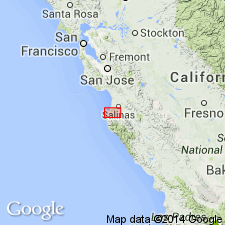
- Usage in publication:
-
- Canyon del Rey Diatomite Member
- Modifications:
-
- Original reference
- Dominant lithology:
-
- Diatomite
- AAPG geologic province:
-
- Coastal basins
Summary:
Pg. 48-67. Canyon del Rey Diatomite Member of Monterey Formation. Name applied to uppermost member of Monterey Formation in type area. Typically a white-weathering, white to cream-colored, very lightweight, punky rock consisting mostly of tests of diatoms, radiolaria, silicoflagellates and foraminifera. Some beds have been altered to porcellanite and opalite indistinguishable from underlying Aguajito Shale Member (new). Bedding is massive in some areas and thin-bedded in others. Thickness 800 feet. Corresponds to Galliher's (1931, Micropaleontology Bull., v. 2, no. 4) unit 1. Unit thins substantially east of Los Laureles Grade road and ultimately lenses out into Santa Margarita Formation or else is cut out by faulting. Upper Miocene. Contains foraminiferal assemblage described by Kleinpell (1938, Miocene stratigraphy of California: Tulsa, Okla., AAPG) as typical of his Delmontian stage.
Named for extensive exposures in Canyon del Rey, west-central CA. Best exposures of stratigraphic section are in road cuts along old Los Laureles Grade road, secs. 9, 10, 15, and 16, T. 16 S., R. 1 W. Unit exposed more or less continuously in long, narrow strip over 8 sq mi and is known to underlie about 12 sq mi in Monterey and Salinas quadrangles.
Source: US geologic names lexicon (USGS Bull. 1350, p. 118).
For more information, please contact Nancy Stamm, Geologic Names Committee Secretary.
Asterisk (*) indicates published by U.S. Geological Survey authors.
"No current usage" (†) implies that a name has been abandoned or has fallen into disuse. Former usage and, if known, replacement name given in parentheses ( ).
Slash (/) indicates name conflicts with nomenclatural guidelines (CSN, 1933; ACSN, 1961, 1970; NACSN, 1983, 2005, 2021). May be explained within brackets ([ ]).

